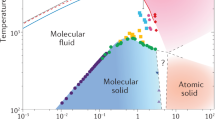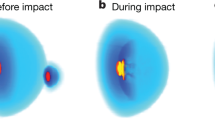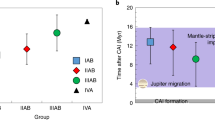Abstract
The phase behaviour of warm dense hydrogen−helium (H−He) mixtures affects our understanding of the evolution of Jupiter and Saturn and their interior structures1,2. For example, precipitation of He from a H−He atmosphere at about 1−10 megabar and a few thousand kelvin has been invoked to explain both the excess luminosity of Saturn1,3, and the depletion of He and neon (Ne) in Jupiter’s atmosphere as observed by the Galileo probe4,5. But despite its importance, H−He phase behaviour under relevant planetary conditions remains poorly constrained because it is challenging to determine computationally and because the extremes of temperature and pressure are difficult to reach experimentally. Here we report that appropriate temperatures and pressures can be reached through laser-driven shock compression of H2−He samples that have been pre-compressed in diamond-anvil cells. This allows us to probe the properties of H−He mixtures under Jovian interior conditions, revealing a region of immiscibility along the Hugoniot. A clear discontinuous change in sample reflectivity indicates that this region ends above 150 gigapascals at 10,200 kelvin and that a more subtle reflectivity change occurs above 93 gigapascals at 4,700 kelvin. Considering pressure–temperature profiles for Jupiter, these experimental immiscibility constraints for a near-protosolar mixture suggest that H−He phase separation affects a large fraction—we estimate about 15 per cent of the radius—of Jupiter’s interior. This finding provides microphysical support for Jupiter models that invoke a layered interior to explain Juno and Galileo spacecraft observations1,4,6,7,8.
This is a preview of subscription content, access via your institution
Access options
Access Nature and 54 other Nature Portfolio journals
Get Nature+, our best-value online-access subscription
$29.99 / 30 days
cancel any time
Subscribe to this journal
Receive 51 print issues and online access
$199.00 per year
only $3.90 per issue
Buy this article
- Purchase on Springer Link
- Instant access to full article PDF
Prices may be subject to local taxes which are calculated during checkout




Similar content being viewed by others
Data availability
The data that support the findings of this study are available in Extended Data Table 1, Extended Data Table 2 and in the Supplementary Information. Upon request, the raw VISAR and SOP images could be transferred to anyone willing to redo the data analysis from the start.
References
Stevenson, D. J. Jupiter’s interior as revealed by Juno. Annu. Rev. Earth Planet. Sci. 48, 465−489 (2020).
Salpeter, E. On convection and gravitational layering in Jupiter and in stars of low mass. Astrophys. J. 181, L83–L89 (1973).
Fortney, J. J. & Hubbard, W. B. Phase separation in giant planets: inhomogeneous evolution of Saturn. Icarus 164, 228–243 (2003).
von Zahn, U. & Hunten, D. M. The helium mass fraction in Jupiter’s atmosphere. Science 272, 849–851 (1996).
Wilson, H. F. & Militzer, B. Sequestration of noble gases in giant planet interiors. Phys. Rev. Lett. 104, 121101 (2010).
Wahl, S. M. et al. Comparing Jupiter interior structure models to Juno gravity measurements and the role of a dilute core. Geophys. Res. Lett. 44, 4649–4659 (2017).
Debras, F. & Chabrier, G. New models of Jupiter in the context of Juno and Galileo. Astrophys. J. 872, 100 (2019).
Bolton, S. J. et al. Jupiter’s interior and deep atmosphere: the initial pole-to-pole passes with the Juno spacecraft. Science 356, 821–825 (2017).
Guillot, T. & Gautier, D. Giant planets. In Treatise on Geophysics (eds Shubert, G. & Spohn, T.) 2nd edn, Vol. 10 (Elsevier, 2014).
Schöttler, M. & Redmer, R. Ab initio calculation of the miscibility diagram for hydrogen-helium mixtures. Phys. Rev. Lett. 120, 115703 (2018).
Stevenson, D. J. & Salpeter, E. E. The phase diagram and transport properties for hydrogen-helium fluid planets. Astrophys. J. Suppl. Ser. 35, 221–237 (1977).
Vorberger, J., Tamblyn, I., Militzer, B. & Bonev, S.A. Hydrogen-helium mixtures in the interiors of giant planets. Phys. Rev. B 75, 024206 (2007).
Lorenzen, W., Holst, B. & Redmer, R. Demixing of hydrogen and helium at megabar pressures. Phys. Rev. Lett. 102, 115701 (2009).
Morales, M. A. et al. Phase separation in hydrogen-helium mixtures at Mbar pressures. Proc. Natl Acad. Sci. USA 106, 1324–1329 (2009).
Loubeyre, P., LeToullec, R. & Pinceaux, J. P. Binary phase diagrams of H2-He mixtures at high temperature and high pressure. Phys. Rev. B 36, 3723–3730 (1987).
Morales, M., Hamel, S., Casperson, K. & Schwegler, E. Hydrogen-helium demixing from first principles: from diamond anvil cells to planetary interiors. Phys. Rev. B 87, 174105 (2013).
Militzer, B., Soubiran, F., Wahl, S. M. & Hubbard, W. Understanding Jupiter’s interior. J. Geophys. Res. Planets 121, 1552–1572 (2016).
Clay, R. C. III, Holzmann, M., Ceperley, D. & Morales, M. Benchmarking density functionals for hydrogen-helium mixtures with quantum Monte Carlo: energetics, pressures and forces. Phys. Rev. B 93, 035121 (2016).
Loubeyre, P. et al. Coupling static and dynamic compressions: first measurements in dense hydrogen. High Press. Res. 24, 25–31 (2004).
Jeanloz, R. et al. Achieving high-density states through shock-wave loading of precompressed samples. Proc. Natl Acad. Sci. USA 104, 9172–9177 (2007).
Celliers, P. et al. Insulator-to-conducting transition in dense fluid helium. Phys. Rev. Lett. 104, 184503 (2010).
Loubeyre, P. et al. Extended data set for the equation of state of warm dense hydrogen isotopes. Phys. Rev. B 86, 144115 (2012).
Knudson, M. & Desjarlais, M. P. Adiabatic release measurements in α-quartz between 300 and 1200 GPa: characterization of α-quartz as a shock standard in the multimegabar regime. Phys. Rev. B 88, 184107 (2013).
Brygoo, S. et al. Analysis of laser shock experiments on precompressed samples using a quartz reference and application to warm dense hydrogen and helium. J. Appl. Phys. 118, 195901 (2015).
Hamel, S., Morales, M. A. & Schwegler, E. Signature of helium segregation in hydrogen-helium mixtures. Phys. Rev. B 84, 165110 (2011).
Soubiran, F., Mazevet, S., Winisdoerffer, C. & Chabrier, G. Optical signature of hydrogen–helium demixing at extreme density-temperature conditions. Phys. Rev. B 87, 165114 (2013).
Soubiran, F. PhD thesis. Ecole Normale Supérieure de Lyon (2012).
Jiang, S. et al. A spectroscopic study of the insulator-metal transition in liquid hydrogen and deuterium. Adv. Sci. 7, 1901668 (2020).
Militzer, B. & Hubbard, W. B. Ab initio equation of state for hydrogen-helium mixtures with recalibration of the giant-planet mass-radius relation. Astrophys. J. 774, 148 (2013).
Soubiran, F. K., Mazevet, S., Winisdoerffer, C. & Chabrier, G. Helium gap in the warm dense matter regime and experimental reflectivity measurements. Phys. Rev. B 86, 115102 (2012).
Püstow, R., Nettelmann, N., Lorenzen, W. & Redmer, R. H/He demixing and the cooling behavior of Saturn. Icarus 267, 323–333 (2016).
Mankovich, C. R. & Fortney, J. J. Evidence for a dichotomy in the interior structures of Jupiter and Saturn from helium phase separation. Astrophys. J. 889, 51 (2020).
Schouten, J. A., de Kuijper, A. & Michels, J. P. Critical line of He-H2 up to 2500 K and the influence of attraction on fluid-fluid separation. Phys. Rev. B 44, 6630–6634 (1991).
Knudson, M. D. et al. Direct observation of an abrupt insulator-to-metal transition in dense liquid deuterium. Science 348, 1455–1460 (2015).
Celliers, P. M. et al. Insulator-metal transition in dense fluid deuterium. Science 361, 677–682 (2018).
Nettelmann, N., Becker, A., Holst, B. & Redmer, R. Jupiter models with improved ab-initio hydrogen equation of state (H-REOS.2). Astrophys. J. 750, 52 (2012).
Saumon, D., Chabrier, G. & Van Horn, H. M. An equation of state for low-mass stars and giant planets. Astrophys. J. 99, 713 (1995).
Mao, H. K., Xu, J. & Bell, P. M. Calibration of the ruby gauge to 800 Kbar under quasi-hydrostatic conditions. J. Geophys. Res. Solid Earth 91, 4673–4676 (1986).
Le Toullec, R. & Loubeyre, P. & Pinceaux, J. P. Refractive-index measurements of dense helium up to 16 GPa at T=298 K: analysis of its thermodynamic and electronic properties. Phys. Rev. B 40, 2368–2378 (1989).
Mills, R. L., Liebenberg, D. H. & Bronson, J. C. Equation of state of fluid n-D2 from P-V-T and ultrasonic velocity measurements. J. Chem. Phys. 68, 2663–2668 (1978).
Dewaele, A., Eggert, J., Loubeyre, P. & LeToullec, R. Measurement of refractive index and equation of state in dense He, H2, H2O, and Ne under high pressure in a diamond anvil cell. Phys. Rev. B 67, 094112 (2003).
Celliers, P. M. et al. Line-imaging velocimeter for shock diagnostics at the OMEGA laser facility. Rev. Sci. Instrum. 75, 4916–4929 (2004).
Miller, J. E. et al. Streaked optical pyrometer system for laser-driven shock-wave experiments on OMEGA. Rev. Sci. Instrum. 78, 034903 (2007).
Caillabet L., Mazevet, S. & Loubeyre, P. Multiphase equation of state of hydrogen from ab-initio calculations in the range 0.2 to 5 g/cc up to 10 eV. Phys. Rev. B 83, 094101 (2011).
Eggert, J. et al. Melting temperature of diamond at ultra-high pressure. Nat. Phys. 6, 40–43 (2010).
Walsh, J. M. & Christian, R. H. Equation of state of metals from shock wave measurements. Phys. Rev. 97, 1544–1556 (1955).
Acknowledgements
We gratefully acknowledge M. Millerioux and F. Occelli for help in the preparation of the pre-compressed targets. We thank F. Soubiran and S. Hamel for useful discussions and F. Soubiran for sharing unpublished data. We thank the OMEGA laser facility management, staff and support crew for excellent shots and diagnostic support with special thanks to C. Sorce, A. Sorce and J. Kendrick. The OMEGA Laser Facility shots were allocated under the NLUF programme. Part of this work was prepared by LLNL under contract number DE-AC52-07NA27344 with support from LLNL LDRD programme and the US Department of Energy Fusion Energy Sciences Program. This work was performed under the auspices of a cooperation agreement CEA/DAM and DOE/NNSA on fundamental sciences. Partial funding for G.W.C. and J.R.R. was provided by NSF Physics Frontier Center award PHY-2020249 and DOE NNSA award DE6NA 0003856.
Author information
Authors and Affiliations
Contributions
R.J., G.W.C. and P.L. designed the project and R.J. was PI of the NLUF proposal. P.L. and S.B. prepared the diamond-anvil cell targets. S.B. and M.M. conducted the OMEGA shots. S.B. and P.L. analysed the data. M.M. and J.R.R. contributed to the data analysis. All authors discussed the results and wrote the manuscript.
Corresponding authors
Ethics declarations
Competing interests
The authors declare no competing interests.
Additional information
Peer review information Nature thanks Tristan Guillot, William Nellis and the other, anonymous, reviewer(s) for their contribution to the peer review of this work.
Publisher’s note Springer Nature remains neutral with regard to jurisdictional claims in published maps and institutional affiliations.
Extended data figures and tables
Extended Data Fig. 1 Compression data for the 11 mol% He mixture pre-compressed to 4 GPa.
Full and open circles indicate experimental data obtained using diamond and sapphire anvils, respectively, with error bars including both random and systematic uncertainties (red shading indicates the pressure range over which our reflectivity measurements indicate immiscibility. Yellow and grey lines show simulation results for a 8 mol% He mixture29, and the Rostock equation of state (REOS) linear mixing calculation for the 11 mol% He mixture, respectively36. The theoretical Hugoniot curves begin at the same initial density as the experimental data points.
Extended Data Fig. 2 Temperature (dark blue, left scale) and pressure (black, right scale) versus shock velocity for the 11 mol% He mixture.
Orange and red triangles denote, respectively, the temperatures and pressures at the shock velocities for which the two discontinuities in sample optical properties are experimentally observed (Figs. 2 and 3); these correspond to the two red triangles determining the immiscibility boundary in Fig. 4 (values and uncertainties are listed in the table below).Yellow and red dashed lines connect the corresponding two points on the immiscibility boundary, and are distinct from the lower-pressure trends (black and dark-blue solid lines are illustrative guides to the eye). The breaks in trends shown here for temperature and pressure as functions of shock velocity in the H–He sample, T(Us) and P(Us), offer independent evidence (from SOP intensities and VISAR timing, respectively) for the discontinuities identified in Fig. 2 from VISAR intensities. Based on thermodynamic scaling46, and not evident at the present scale, the low-pressure trends are expected to have positive curvature, T′′(Us) and P′′(Us) > 0. The apparent temperatures obtained between shock velocities of 23 km s–1 and 28 km s–1 lie below the red dashed line, implying anomalous thermal (temperature, thermal energy, specific heat) and/or optical properties in the region of immiscibility. The two experimentally determined (P, T) points on the immiscibility boundary line obtained from the figure are given in the table (uncertainties in last digit(s) given in parentheses).
Extended Data Fig. 3 Reflectivity of pure hydrogen versus temperature and density.
Circles are the experimental data, previously published for densities below 0.32 g per mole (see ref. 24) and unpublished for higher densities. The colour of each point indicates the measured reflectivity at the shock front, with background colour filling giving the fitted reflectivity. The hydrogen density is estimated using the ab initio equation of state of ref. 44, which is in good agreement with experiment24. The density−temperature paths of the two H−He Hugoniot curves measured here, for 11 mol% He at 4 GPa pre-compression and for 33 mol% He at 2 GPa pre-compression, are plotted as full and dashed black lines respectively. The error bars have been estimated by propagating the random and systematic uncertainties in the case of pure hydrogen as for the present H–He measurements, as explained in Methods.
Extended Data Fig. 4 Saturated value of reflectivity along the Hugoniot of the pre-compressed H-He mixture, shown as a function of He concentration.
Squares give the experimental values, as indicated by horizontal dashed lines in Fig. 3: blue and green for the 11 and 33 mol% He mixtures, respectively. Black points are from the calculations of ref. 25. The error bars are estimated from those of the reflectivity at saturation in pure hydrogen and in the H–He mixture.
Extended Data Fig. 5 Energy versus temperature along the H−He Hugoniot for 11 mol% He mixture pre-compressed to 4 GPa.
Full and open circles are experimental data for diamond and sapphire anvils, respectively (red shading indicates the pressure range over which our reflectivity measurements indicate immiscibility); the orange solid line is the Hugoniot calculated for an 8 mol% He mixture29. Experiment and calculation are expected to have similar slopes below 2 kK, in the homogeneous H2−He mixture, and above 12 kK in the homogeneous H−He mixture. The dashed line is a smooth curve connecting these two slopes. The deviation from this smooth curve is associated with dissociation of molecular hydrogen, according to the calculation. A similar bump is observed in the experiments, concomitant with the sudden rise in reflectivity and thus signalling the transition to an electronically conducting state. Error bars are estimated by propagating random and systematic uncertainties as described in Methods.
Extended Data Fig. 6 Boundary for He ionization.
Blue shading indicates where a few per cent ionization of He first appears, based on experimental He reflectivity measurements21, subsequently analysed by Soubiran30 in the framework of an intrinsic semiconductor model with a bandgap energy depending on density and temperature. The blue dashed line is drawn using this He gap model30, and the REoS table to estimate the He density36. The intrinsic ionization fraction of He depends exponentially on the ratio of gap energy to temperature, Eg/kBT. He ionization is considered sufficient to perturb H−He miscibility properties when the temperature exceeds T = Eg/3kB, upon entering the blue-shaded domain. The present Hugoniot data (open circles) are far from this boundary. Jupiter’s internal isentrope crosses into the He ionization domain only near its central maximum pressure, implying that no He ionization should take place inside the planet. Error bars are those of the data in Table 1.
Extended Data Fig. 7 Relative contributions of random and systematic uncertainties illustrated by the pressure-versus-compression and reflectivity-versus-temperature data points.
In both figures, the inset is a zoom of the data point indicated by the circle.
Extended Data Fig. 8 Reflectivity versus shock velocity obtained from the decaying shock analysis for all experiments.
a, The plot is constructed by adding the reflectivity evolutions obtained from the decaying shock analysis of the VISAR images of all experiments (see Supplementary Information). The 5 different colours identify the 5 different experiments highlighted here around the two reflectivity discontinuous changes. All other experiments are plotted in grey. The discrete more accurate data points obtained at the quartz/H−He sample interface are plotted as circles. A crossover transition is observed at about 28.5 km s–1 between the high-reflectivity to the low-reflectivity behaviours as the H−He mixture goes from the demixed to the mixed states. b−f, The sample photos and the VISAR images of selected experiments, all using sapphire anvils, are shown. The blue lines represent the propagation of the quartz edge disturbances that can perturb the measurements at late time (see Methods). Error bars are estimated by propagating random and systematic uncertainties as described in Methods.
Supplementary information
Supplementary Information
This file contains a Supplementary Table showing decaying shock analysis for all experiments and an overview figure of the reflectivity versus shock velocity obtained from the decaying shocks of all experiments.
Rights and permissions
About this article
Cite this article
Brygoo, S., Loubeyre, P., Millot, M. et al. Evidence of hydrogen−helium immiscibility at Jupiter-interior conditions. Nature 593, 517–521 (2021). https://doi.org/10.1038/s41586-021-03516-0
Received:
Accepted:
Published:
Issue Date:
DOI: https://doi.org/10.1038/s41586-021-03516-0
This article is cited by
-
Tidal Dissipation in Giant Planets
Space Science Reviews (2024)
-
Melting curve of superionic ammonia at planetary interior conditions
Nature Physics (2023)
-
Materials under extreme conditions using large X-ray facilities
Nature Reviews Methods Primers (2023)
-
Accurate temperature diagnostics for matter under extreme conditions
Nature Communications (2022)
-
Stardust in the deep interior of low-mass planets
Nature Astronomy (2021)
Comments
By submitting a comment you agree to abide by our Terms and Community Guidelines. If you find something abusive or that does not comply with our terms or guidelines please flag it as inappropriate.



